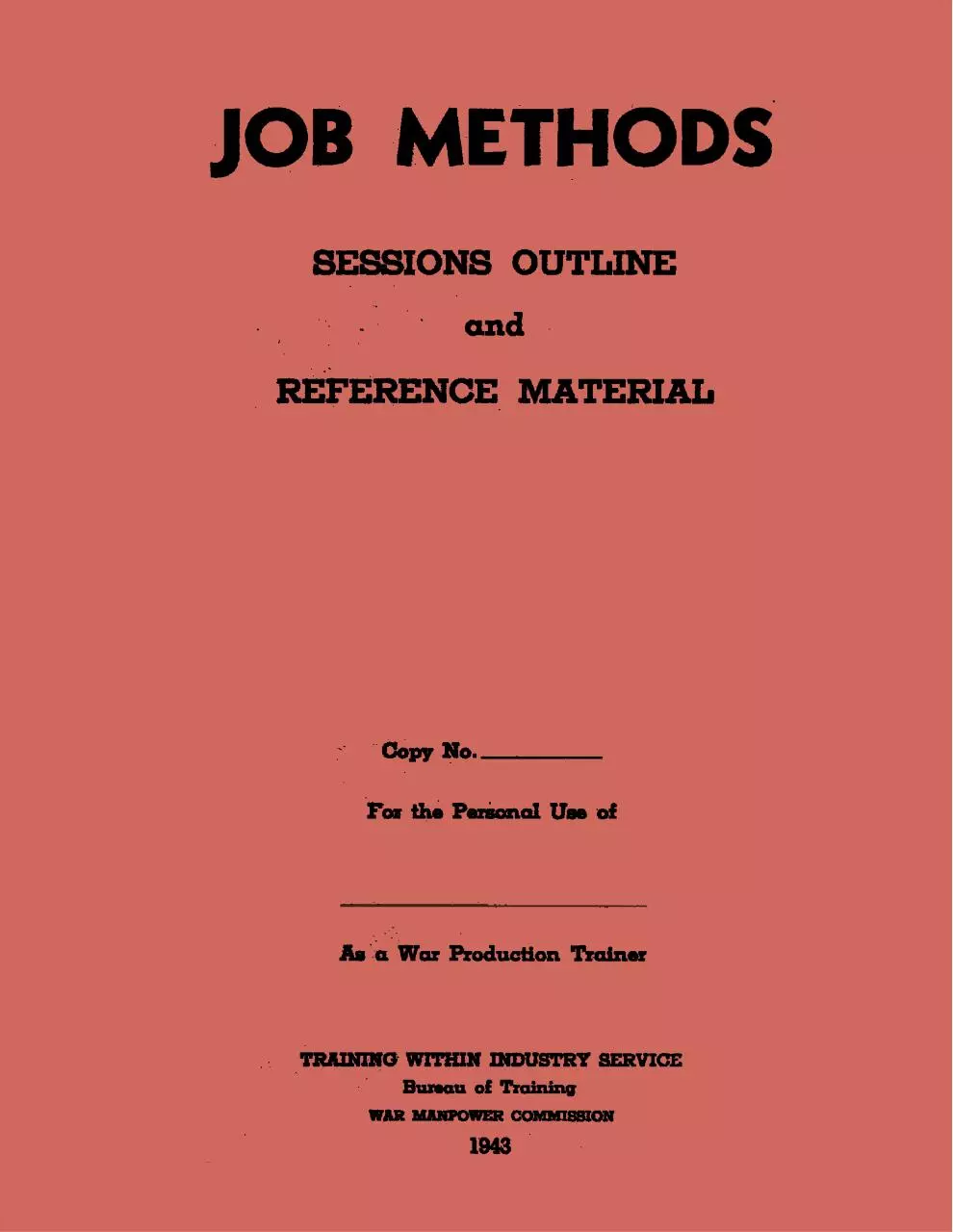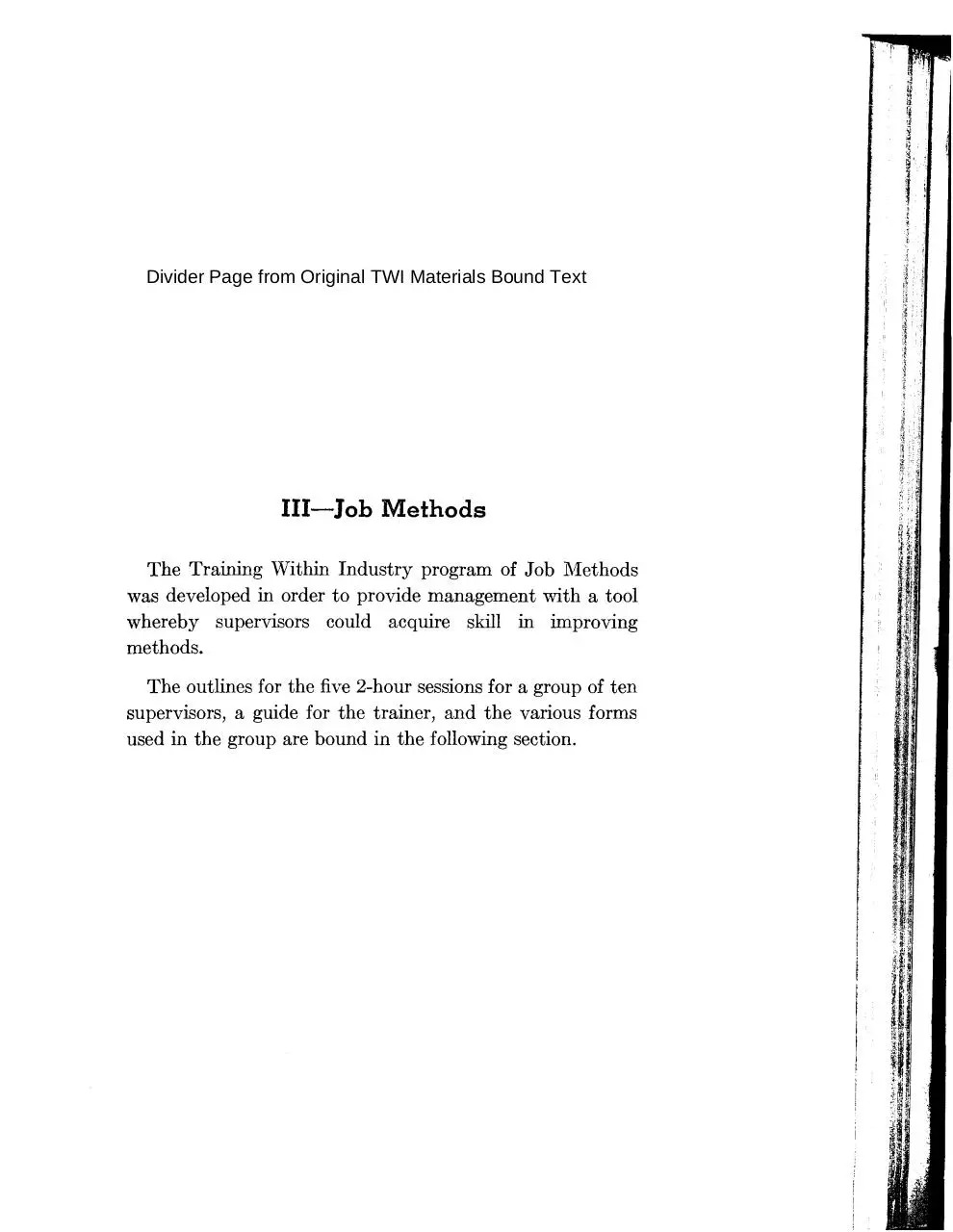TWI Job Methods Manual (PDF)
File information
This PDF 1.6 document has been generated by Adobe Acrobat 6.0 / Adobe Acrobat 6.0 Paper Capture Plug-in, and has been sent on pdf-archive.com on 18/10/2016 at 17:26, from IP address 24.196.x.x.
The current document download page has been viewed 2679 times.
File size: 4.13 MB (114 pages).
Privacy: public file





File preview
Divider Page from Original TWI Materials Bound Text
111-Job Methods
The Training Within Industry program of Job Methods
was developed in order to provide management with a tool
whereby supervisors could acquire skill in improving
methods.
The outlines for the five 2-hour sessions for a group of ten
supervisors, a guide for the trainer, and the various forms
used in the group are bound in the following section.
WAR MANPOWER COMMISSION
WASHINGTON, D. C.
T o THEWARPRODUCTION
TRAINER:
As you help war production supervisors use this JOB METHODS program, you have a
rare opportunity to serve the Nation in this emergency.
You also have a major obligation to the Nation, as well as to each supervisor.
The situation is a very practical one. Most of the men with whom you will work have
had years of experience. They have latent ideas which, if properly developed, will increase
production, reduce lost time, prevent waste of material, and increase the use of machinery
and equipment. These men command your respect because of their knowledge.
Your function is to show them how to fully develop their ideas for practical use and present
them successfully to their Managements. You have two jobs to do: One is to help the supervisor to acquire skill in the use of this "precision tool" for improving job methods; the other
is to improve your own ability in training supervisors how to use i t effectively.
You should strive with all the energy and diligence you possess to lead each group in the
very best possible way-and to do a still better job with each succeeding group.
To assure a uniformly high standard, you should ALWAYS work from this outline. Never
deviate from it. Don't trust to your memory, regardless of how many times you may present
the plan. It is not difficult and if you follow instructions you can't fail. Furthermore, you
will find it a fascinating job.
Once again, leadership in this Jobs Methods Program presents a personal opportunity
and an obligation.
Sincerely,
Dircdor
fininin; Within Indmtru.
SKILL IN IMPROVING JOB METHODS MEETS ONE OF THE
SUPERVISOR'S FIVE NEEDS
1. Knowledge of the Work.-Materials, machines, tools, processes, operations, products, and
how 'they are made and used.
2. Knowledge of Responsibilities.-Policies, agreements, rules, regulations, schedules, interdepartmental relationships.
These two knowledge needs must be met currently and locally by each plant or
company.
Such knowledge must be provided if each supervisor is to know his job and is to
have a clear understanding of his authority and responsibilities as a part of
management.
3. Skill in Instructing.-Shortening training time by breaking down each job into units easily
learned, making the learner receptive, presenting the instruction, trying out his performance, following up for results.
4. Skill in Improving Methods.-Utilizing materials, machines, and manpower more effectively
by having supervisors study each operation in order to eliminate, combine, rearrange,
and simplify details of the job.
5. Skill in Leading.-Increasing production by helping supervisors to improve their understanding of individuals, their ability to size up situations, and their ways of working
with people.
These three skills must be acquired individually. Practice and experience in
using them enable both new and experienced supervisors to recognize and
solve daily problems promptly.
Training Within Industry Service assists companies in giving their supervisors
a start in acquiring these skills through three 10-hour programs: Job Instruction, Job Methods, Job Relations.
These skills, acquired through this training, must become a part of day-to-day OPERATIONS. I n no other way can production be so quickly influenced and manpower conserved.
Confidence and resourcefulness in how to proceed, not standardized solutions and rules,
are developed. These enable supervisors to get good teamwork, to give better service, and
to get out more production.
SESSIONS OUTLINE
FOR THE
FIVE TWO - HOUR SESSIONS
Paragraphs in quotation marks are to be presented either by using the exact words of the text or
expressing the exact meaning in the Trainer's own
words. In case of the latter, special care should be
taken to convey the exact meaning every time.
Wherever the expression "(some discussion)"
appears, there should be brief discussion to make
the point clear or to reach agreement with the group.
Words in bold face are key words which provide
the Trainer with a quick clue to the statement made
in the sentence.
4
TRAINING WITHIN INDUSTRY PLAN
BEFORE YOU B E G I N S E S S I O N I
BE SURE YOU HAVE THESE MATERIALS
1 Attendance Record
1 Suggested Introduction
14 Present Method Layouts
14 Proposed Method Layouts
14
14
14
28
J M Instruction Cards
Present Method Break-Downs
Proposed Method Break-Downs
Blank Break-down Sheets
Demonstration Kit consisting of:
1 Fixture
1 Stamp Pad
2 Jigs
250 Brass Cards
2 Staplers
250 Copper Cards
1 "TOP" Stamp
BE AT THE PLANT 30 MINUTES BEFORE SESSION IS DUE TO OPEN
See the Plant Executive. Make certain he is prepared to open the meeting
with a suitable introduction. Give hirn a copy of the SUGGESTED INTRODUCTION if he has not already received one.
BE AT THE MEETING ROOM 15 MINUTES AHEAD OF TIME
Arrange CHAIRS around the conference TABLE. If there is no table, place
chairs in the shape of a "U."
Put a FINISHED SHIELD on the table, also ONE COPPER SHEET and
ONE BRASS SHEET.
Place TWO CHAIRS, to be used as SUPPLY BOXES, S I X F E E T BACK of
the table.
Put a supply of COPPER SHEETS on one chair, and of BRASS SHEETS on
the other.
Place TWO waste-paper BASKETS to the RIGHT of the table (to serve as
SCRAP BINS).
Put one STAPLER, the STAMP PAD, and STAMP on the table.
Place a waste-paper BASKET to the LEFT of the table (to serve as a TOTE
BOX).
Put the extra STAPLER, the JIGS and FIXTURE, out of sight of the Group.
Place SAMPLE HAND-OUT SHEETS and INSTRUCTION CARDS on
the table.
WORK FROM THE OUTLINE-DON'T
TRUST TO MEMORY
FOR IMPROVING JOB METHODS
5
OUTLINE FOR SESSION I
TIME
TABLE
Allow
6 min.
1. INTRODUCTION BY THE PLANT EXECUTIVE
Suggested introduction
- Program
6 min.
t o here
Allow
10 min.
name and purpose.
-
Need for Job Methods in this company.
-
Pledge of cooperation and support.
-
Schedule of Sessions 11, 111, IV and V.
-
Introduction of the trainer.
2. INTRODUCTION BY THE TRAINER
Establish an informal atmosphere
-
See p. 70
Write your name on the blackboard and state your
industrial connection.
name cards if practicable. Have members
put names of their departments on cards.
- Use
- Have each member say a word about his job.
-
"This is an informal conference, similar to Job
Instruction Training Sessions. Ask questions
at any time. No notes are necessary."
"five needs" of every supervisor. (Not
over 3 minutes.)
- Cover the
"What is our purpose?"
not here to tell you how to run your jobs or
to discuss the technical part of your work.
We will discuss one problem common to all of
us: How to improve Job Methods."
- "I'm
SM p. 71
Download TWI Job Methods Manual
TWI_Job_Methods_Manual.pdf (PDF, 4.13 MB)
Download PDF
Share this file on social networks
Link to this page
Permanent link
Use the permanent link to the download page to share your document on Facebook, Twitter, LinkedIn, or directly with a contact by e-Mail, Messenger, Whatsapp, Line..
Short link
Use the short link to share your document on Twitter or by text message (SMS)
HTML Code
Copy the following HTML code to share your document on a Website or Blog
QR Code to this page

This file has been shared publicly by a user of PDF Archive.
Document ID: 0000495860.